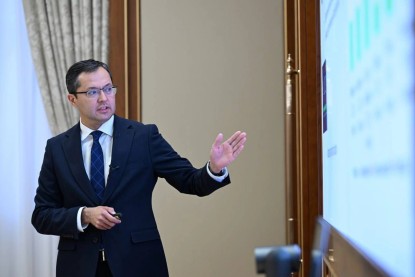Economic growth in the developing economies of the Europe and Central Asia region is stabilizing after a series of crises but at levels well below the early-2000s, says the World Bank’s Economic Update for the region, released today.
Regional growth is expected to moderate to 3.3% this year from 3.5% in 2023, slowing further to 2.6% in 2025. This is significantly weaker than the 5.1% average growth of 2000-09 and below what is needed for the region’s middle-income countries to achieve their aspiration of attaining high-income status within a generation or two. Lower inflation is prompting some central banks to start cutting policy rates this year. Policy caution prevails, however, amid concerns about persistent price pressure.
The report calls for a major overhaul of education systems across the region, particularly higher education, to unlock the human talent needed to reinvigorate economic growth and boost convergence with high-income countries.
“Countries of the Europe and Central Asia region have ably navigated the recent shocks of high inflation, the fallout from Russia’s invasion of Ukraine, and weak expansion in the European Union, the region’s key export market,” said Antonella Bassani, World Bank Vice President for Europe and Central Asia. “To achieve stronger productivity growth over the longer term, it will be important for the countries of the region to improve substantially the quality of both secondary and higher education, key for bolstering human capital and creativity.”
Currently, economic growth in the developing economies of Europe and Central Asia is underpinned by private consumption because of rising wages, government transfers to households, and falling inflation. Remittance inflows are also above pre-pandemic levels, and they continue to support economic expansion in the Western Balkans, the South Caucasus, and Central Asia.
Tourism is another bright spot in the region’s growth story, with international tourist arrivals surpassing pre-pandemic levels. Türkiye saw almost 30% more tourist arrivals during the first half of this year compared to the same period in 2018 and 2019. Recovery in goods exports, however, has faded due to the slowdown in the European Union.
In Ukraine, substantial damage from Russia’s invasion and extensive electricity disruptions are likely to slow growth from 5.3% last year to 3.2% this year and 2% in 2025. In Russia, tighter monetary policy and increasingly binding constraints on production capacity and labor resources are expected to slow growth from 3.6% in 2023 to 3.2% this year and 1.6% in 2025.
Growth in Türkiye, the region’s second largest economy after Russia, is set to slow to 3.2% this year, from 5.1% in 2023 because of the ongoing rebalancing of the economy from consumption-led expansion and the normalization of monetary and fiscal policies. Investment growth also slowed sharply because of cuts to public investment, high borrowing costs, and a further cooling of construction activity.
Investing in Education to Boost Human Capital and Spur Growth
In a special analysis of talent and its critical role as a driver of economic growth, the report finds that education quality has been deteriorating at a critical time when many countries in the region already face substantial demographic and human capital challenges. The population is aging rapidly in many countries and labor force participation remains low in some parts of the region, especially for women.
“The greatest scope for boosting long-term growth in the region lies in raising the quality of education, especially higher education,” said Ivailo Izvorski, World Bank Chief Economist for Europe and Central Asia. “Prioritizing quality of education and supporting lifelong learning will help countries bolster their human capital, reduce talent misallocation and waste, energize innovation, and drive sustainable economic growth and development.”
The report notes that, across the region, enrollment rates at all levels of education are high. The problem lies with the quality of education, which has deteriorated in recent years. Test scores on the Program for International Student Assessment (PISA), which is administered to 15-year-old students, have declined substantially over the last decade. Gaps in the quality of basic (primary and secondary) education are particularly large for students from disadvantaged backgrounds.
Higher education is underperforming even more than basic education. Countries in other regions with a similar quality of basic education or a similar income level have better universities. For example, there are only nine institutions from the region in the Top 500 Times Higher Education ranking of world universities.
Weaknesses in higher education systems include outdated curricula, lack of investment in equipment and infrastructure, poor management, and the disconnect between education and labor market needs. Addressing these challenges will require efforts to accelerate curriculum reforms, especially in science, technology, engineering, and math (STEM) subjects, improving the quality of higher education, and enlisting more and better trained teachers to boost human capital creation.
| Europe and Central Asia Country Forecast | ||||||
| (Real GDP growth at market prices in percent, unless indicated otherwise) | ||||||
| Country | 2021 | 2022 | 2023 | 2024e | 2025f | 2026f |
| Albania | 8.9 | 4.9 | 3.4 | 3.3 | 3.4 | 3.4 |
| Armenia | 5.8 | 12.6 | 8.3 | 5.5 | 5.0 | 4.6 |
| Azerbaijan | 5.6 | 4.6 | 1.1 | 3.2 | 2.7 | 2.4 |
| Belarus | 2.4 | -4.7 | 3.9 | 4.0 | 1.2 | 0.8 |
| Bosnia and Herzegovina | 7.3 | 3.8 | 1.6 | 2.8 | 3.2 | 3.9 |
| Bulgaria | 7.7 | 3.9 | 1.8 | 2.2 | 2.8 | 2.7 |
| Croatia | 13.0 | 7.0 | 3.1 | 3.5 | 3.0 | 2.8 |
| Georgia | 10.6 | 11.0 | 7.5 | 7.5 | 5.2 | 5.0 |
| Kazakhstan | 4.3 | 3.2 | 5.1 | 3.4 | 4.7 | 3.5 |
| Kosovo | 10.7 | 4.3 | 3.3 | 3.8 | 3.9 | 4.0 |
| Kyrgyz Republic | 5.5 | 9.0 | 6.2 | 5.8 | 4.5 | 4.5 |
| Moldova | 13.9 | -4.6 | 0.7 | 2.8 | 3.9 | 4.5 |
| Montenegro | 13.0 | 6.4 | 6.3 | 3.4 | 3.5 | 3.2 |
| North Macedonia | 4.5 | 2.2 | 1.0 | 1.8 | 2.5 | 3.0 |
| Poland | 6.9 | 5.6 | 0.2 | 3.2 | 3.7 | 3.4 |
| Romania | 5.7 | 4.1 | 2.1 | 2.0 | 2.7 | 3.5 |
| Russian Federation | 5.9 | -1.2 | 3.6 | 3.2 | 1.6 | 1.1 |
| Serbia | 7.7 | 2.5 | 2.5 | 3.8 | 4.2 | 4.0 |
| Tajikistan | 9.4 | 8.0 | 8.3 | 7.2 | 5.5 | 5.0 |
| Türkiye | 11.4 | 5.5 | 5.1 | 3.2 | 2.6 | 3.8 |
| Ukraine | 3.4 | -28.8 | 5.3 | 3.2 | 2.0 | 7.0 |
| Uzbekistan | 8.0 | 6.0 | 6.3 | 6.0 | 5.8 | 5.9 |











